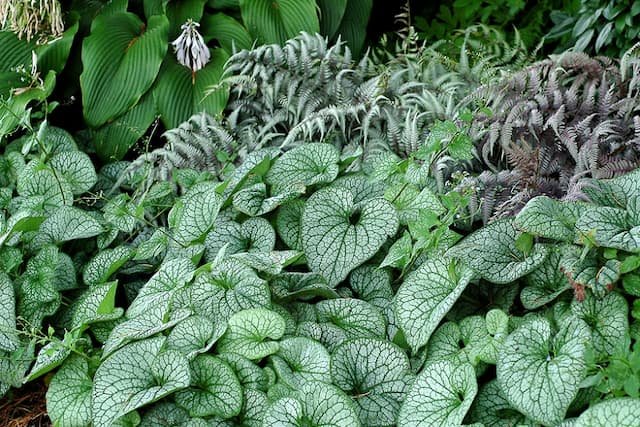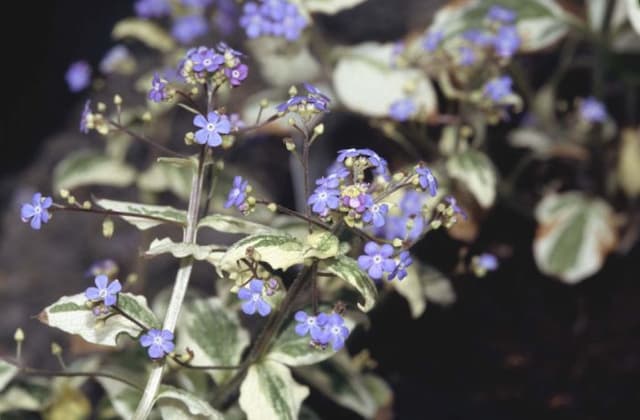Comfrey Symphytum officinale blue-flowered

ABOUT
The common comfrey, with its blue-flowered variety, is a hardy perennial plant known for its clustering growth habit. The most striking feature of this plant is its bell-shaped blue flowers which hang in clusters from bending stems. The blossoms possess a delicate charm, drawing pollinators like bees to its nectar-rich depths. Beneath these blooms, the foliage is lush and deep green, with leaves that are broad at the base and narrower towards the tip, exhibiting a textured surface with a slightly hairy touch. Common comfrey is also recognized for its sturdy nature and can often be found near water bodies or in moist, shaded garden spots. The whole plant exudes a certain wild, untamed beauty, grounding its presence solidly within the landscape it inhabits.
About this plant
 Names
NamesFamily
Boraginaceae
Synonyms
Common Comfrey, Knitbone, Boneset, Knitback, Consound, Blackwort, Bruisewort, Slippery Root, Healing Herb, Ass Ear
Common names
Symphytum officinale.
 Characteristics
CharacteristicsLife cycle
Perennials
Foliage type
Deciduous
Color of leaves
Green
Flower color
Blue
Height
2-3 feet (0.6-0.9 meters)
Spread
1-2 feet (0.3-0.6 meters)
Plant type
Herb
Hardiness zones
4-9
Native area
Europe
Benefits
 General Benefits
General Benefits- Improves Soil Fertility: Symphytum officinale, commonly known as comfrey, has deep roots that mine the subsoil for minerals, which are then brought to the surface and can enrich the soil around the plant.
- Compost Activator: Comfrey leaves are rich in nitrogen and can help speed up the decomposition process when added to compost piles, making it a valuable addition to composting efforts.
- Natural Fertilizer: The nutrient-rich leaves of comfrey can be used to make a liquid fertilizer for plants, providing essential nutrients like potassium, phosphorus, and nitrogen.
- Animal Fodder: It can be used as a fodder plant for livestock, providing a source of protein and other nutrients when added to the animals' diet in moderation.
- Attracts Beneficial Wildlife: The flowers of comfrey attract bees, butterflies, and other pollinators to the garden, which is beneficial for pollinating crops and maintaining biodiversity.
- Ground Cover: Comfrey can be used as ground cover to suppress weeds, as its dense growth can help prevent weed seeds from germinating and establishing.
- Prevents Erosion: With its deep roots, comfrey can help stabilize soil and prevent erosion, particularly on slopes or in areas with loose soil.
- Garden Mulch: The leaves can be used as mulch around plants, which gradually break down and add nutrients to the soil while helping retain soil moisture.
- Supports Permaculture Practices: As a perennial plant, comfrey is well-suited to permaculture gardens where it can serve multiple functions over its long life span without the need for replanting each year.
 Medical Properties
Medical Properties- Wound healing: Comfrey, the common name for Symphytum officinale blue-flowered, contains allantoin which is known to speed up the healing process by stimulating the growth of new cells.
- Anti-inflammatory: The plant has rosmarinic acid, which contributes to its anti-inflammatory properties that may help reduce swelling and inflammation.
- Pain relief: Traditional use includes application of comfrey extracts to alleviate pain, particularly in conditions like sprains, bruises, and bone fractures.
- Tissue regeneration: Due to its high mucilage content, comfrey is sometimes used in topical remedies aimed at the regeneration of tissue.
 Air-purifying Qualities
Air-purifying QualitiesThis plant is not specifically known for air purifying qualities.
 Other Uses
Other Uses- Fertilizer: Comfrey leaves are high in nitrogen and can decompose quickly, making them an excellent addition to compost piles or used as a direct mulch to enrich soil fertility.
- Livestock feed: Comfrey can be used as fodder for livestock, particularly rabbits and pigs, due to its protein-rich leaves.
- Natural barrier: With its dense growth, comfrey can be planted to form a green barrier or living wall, which can provide privacy or mark boundaries.
- Dynamic accumulator: Comfrey has deep roots that mine the subsoil for minerals, potentially bringing up nutrients and making them available to other plants when its leaves are used as mulch or in compost.
- Plant propagation aide: Some gardeners use comfrey liquid (made by steeping the leaves in water) as a mild natural root growth stimulant for cuttings of other plants.
- Pond companion: Planted around the edges of a pond, comfrey can help in stabilizing the bank and offer habitat for beneficial insects and amphibians.
- Biodegradable pot: Young plant starts can be planted in rolled up comfrey leaves, which will decompose in the soil, reducing the need for plastic pots.
- Natural dye: The roots of comfrey can be used to create a natural reddish-brown dye for fabric and yarn.
- Leaf mould: Comfrey leaves can be collected and stored to rot down into leaf mould, a soil conditioner that improves soil structure and water retention.
- Bee and insect attractant: Comfrey flowers are a good source of nectar and attract bees, butterflies, and other beneficial insects, supporting biodiversity in the garden.
Interesting Facts
 Feng Shui
Feng ShuiThe Comfrey is not used in Feng Shui practice.
 Zodiac Sign Compitability
Zodiac Sign CompitabilityThe Comfrey is not used in astrology practice.
 Plant Symbolism
Plant Symbolism- Healing: Symphytum officinale, commonly known as comfrey, is traditionally associated with healing due to its medicinal properties that aid in wound recovery and reduce inflammation.
- Protection: Comfrey has been thought to offer protection against negative influences and was historically used in folk rituals to safeguard travelers and to protect against theft.
- Safe Travels: Carrying comfrey during travel was believed to ensure safety and provide good luck on journeys, stemming from its protective lore.
- Homeopathic Remedy: As comfrey has a place in homeopathic treatments, its symbolism extends to natural wellness and alternative medicine, honoring the plant's ability to alleviate various ailments.
- Money: Folklore suggests that comfrey can attract money or good fortune, possibly because of its all-around beneficial properties and its potential to facilitate prosperity.
 Water
WaterComfrey, also known as Symphytum officinale with blue flowers, prefers consistent moisture but doesn't like to be waterlogged. It can be watered deeply once a week, providing about one gallon of water per plant to ensure the soil is moistened to a depth of several inches. In hot and dry conditions, watering may be increased to twice a week. During the winter, reduce watering as the plant enters dormancy. Always check the top inch of the soil before watering; if it feels dry, it's time to water.
 Light
LightComfrey thrives best in full sun to partial shade. It should be positioned in a spot where it can receive at least four to six hours of sunlight per day. If in a particularly hot climate, providing some afternoon shade can help protect the plant from excessive heat.
 Temperature
TemperatureComfrey is hardy and tolerates a wide range of temperatures, thriving best when the atmospheric temperature ranges between 50°F and 80°F. It can survive temperatures down to around -40°F and up to about 120°F. However, temperatures in the ideal range will promote the most vigorous growth.
 Pruning
PruningComfrey should be pruned to remove dead or wilted leaves and to control its growth, as it can become quite large. Pruning can be done in late winter or early spring, before new growth begins. It can also be cut back after flowering to encourage a second bloom.
 Cleaning
CleaningAs needed
 Soil
SoilComfrey (the most common name for Symphytum officinale blue-flowered) prefers rich, well-draining soil with a pH between 6.0 and 7.0. A good soil mix for comfrey can be made by combining two parts garden loam, one part peat moss, and one part perlite or coarse sand to ensure good drainage.
 Repotting
RepottingComfrey plants are typically not repotted frequently as they are often grown outdoors. If grown in containers, they can be repotted every 2-3 years to refresh the soil and provide room for growth.
 Humidity & Misting
Humidity & MistingComfrey thrives in outdoor conditions and isn't particularly humidity-sensitive. It can grow well in the typical humidity levels found in most temperate climates.
 Suitable locations
Suitable locationsIndoor
Place comfrey in a sunny spot with well-draining soil.
Outdoor
Choose a sunny or semi-shaded area with fertile soil for comfrey.
Hardiness zone
Comfrey is suitable for USDA hardiness zones 4-9.
 Life cycle
Life cycleThe common name of Symphytum officinale with blue flowers is comfrey. The life cycle begins with seed germination, which occurs in early spring when soil temperatures warm. After germination, seedlings develop a rosette of leaves at the soil surface and an extensive root system. Comfrey then enters a vegetative growth phase characterized by the rapid development of large, hairy leaves. Flowering occurs in late spring to early summer, with clusters of blue, bell-shaped flowers that attract various pollinators. After pollination, the plant sets seeds, which mature by late summer, completing the cycle as the plant either dies back in winter (in colder climates) or remains semi-evergreen, depending on regional conditions.
 Propogation
PropogationPropogation time
Spring-Early Summer
Propogation: Common comfrey (Symphytum officinale) with blue flowers can be easily propagated through root cuttings, which is the most popular method used. The best time to take root cuttings is in late fall or early winter when the plant is dormant. To propagate, gardeners simply need to dig up a section of the plant's root and cut it into sections, each being about 2 to 4 inches (5 to 10 cm) long. These root segments are then planted horizontally or vertically in soil, with horizontal planting being more common, ensuring that the top part of the cutting is just below the soil surface. In a few weeks, these cuttings will start to show signs of growth, developing shoots and eventually forming new plants that are true to the parent. This method is highly efficient and reliable, making it an excellent choice for expanding one's collection of common comfrey plants.









